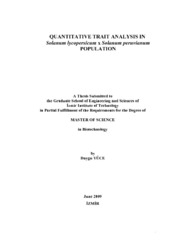Please use this identifier to cite or link to this item:
https://hdl.handle.net/11147/3399Full metadata record
| DC Field | Value | Language |
|---|---|---|
| dc.contributor.advisor | Frary, Anne | - |
| dc.contributor.author | Yüce, Duygu | - |
| dc.date.accessioned | 2014-07-22T13:51:28Z | - |
| dc.date.available | 2014-07-22T13:51:28Z | - |
| dc.date.issued | 2009 | - |
| dc.identifier.uri | http://hdl.handle.net/11147/3399 | - |
| dc.description | Thesis (Master)--Izmir Institute of Technology, Biotechnology, Izmir, 2009 | en_US |
| dc.description | Includes bibliographical references (leaves: 39-46) | en_US |
| dc.description | Text in English; Abstract: Turkish and English | en_US |
| dc.description | x, 46 leaves | en_US |
| dc.description.abstract | Tomato is an important vegetable for both the economy and the human diet and it is a good model system for genetic studies. Because of tomato.s commercial importance, agronomic traits such as yield, fruit weight, size, color and firmness are very significant for the tomato processing industry and fresh consumption. However with increased attention on health, plant breeders also consider the improvement of health related traits of tomato such as antioxidant characters. Improvement of these desired traits is very difficult because many plant traits are controlled by more than one gene. In this study both health-related and agronomically important traits were characterized in an BC2F2 S. peruvianum mapping population of 118 individuals. All plants were phenotypically characterized for total water-soluble antioxidant activity, phenolic and vitamin C contents as well as several agronomic traits including fruit weight and shape, color and firmness. All antioxidant traits showed good variation in the population with the S. peruvianum parent having significantly higher values for all three antioxidant traits. Based on trait distributions and transgressive segregation in the population, it was expected that some alleles from the wild species S. peruvianum had the capacity for improvement of both antioxidant and agronomic traits of cultivated tomato. Both parents were genotypically characterized with 169 genetic markers including 96 COSII and 73 SSR markers. Good levels of polymorphism were identified with both types of marker. Thus, it was shown that the population contains sufficient trait and genotypic variation for efficient mapping of quantitative trait loci. | en_US |
| dc.language.iso | en | en_US |
| dc.publisher | Izmir Institute of Technology | en_US |
| dc.rights | info:eu-repo/semantics/openAccess | en_US |
| dc.subject.lcc | SB349 .Y94 2009 | en |
| dc.subject.lcsh | Tomatoes--Genetic | en |
| dc.subject.lcsh | Quantitative genetics | en |
| dc.subject.lcsh | Antioxidants | en |
| dc.title | Quantitative trait analysis in solanum lycopersicum x solanum peruvianum | en_US |
| dc.type | Master Thesis | en_US |
| dc.institutionauthor | Yüce, Duygu | - |
| dc.department | Thesis (Master)--İzmir Institute of Technology, Bioengineering | en_US |
| dc.relation.publicationcategory | Tez | en_US |
| dc.identifier.wosquality | N/A | - |
| dc.identifier.scopusquality | N/A | - |
| item.openairecristype | http://purl.org/coar/resource_type/c_18cf | - |
| item.openairetype | Master Thesis | - |
| item.languageiso639-1 | en | - |
| item.grantfulltext | open | - |
| item.fulltext | With Fulltext | - |
| item.cerifentitytype | Publications | - |
| Appears in Collections: | Master Degree / Yüksek Lisans Tezleri | |
Files in This Item:
| File | Description | Size | Format | |
|---|---|---|---|---|
| T000183.pdf | MasterThesis | 389.4 kB | Adobe PDF |  View/Open |
CORE Recommender
Page view(s)
43,254
checked on Jun 16, 2025
Download(s)
96
checked on Jun 16, 2025
Google ScholarTM
Check
Items in GCRIS Repository are protected by copyright, with all rights reserved, unless otherwise indicated.